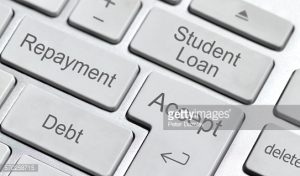Student loan debt is no secret to the American public. Unfortunately, the financial crisis faced by millions of students is continuing to grow.
According to the PwC Employee Wellness Survey, 42 percent of millennial employees have student loan debt. Twenty-six percent of Gen-X employees have student debt, as well as 11 percent of baby boomer employees.
Total Student Debt in the U.S.
 First of all, the state of student loan debt isn’t getting better. These figures continue to rise each year in the U.S. In fact, the Federal Reserve Bank of New York reported that 44 million Americans hold a debt that has hit $1.31 trillion.
First of all, the state of student loan debt isn’t getting better. These figures continue to rise each year in the U.S. In fact, the Federal Reserve Bank of New York reported that 44 million Americans hold a debt that has hit $1.31 trillion.
Not quite sure how to comprehend that number? The total outstanding balance on American credit cards is just $779 billion.
Perhaps, this might put things in perspective: The entire economy of Russia is only slightly larger than the U.S. student loan debt, with their gross domestic product coming in at $1.33 trillion annually.
It’s VERY Unlikely That a Loan Is Forgiven
It’s a common misunderstanding among students that their student loans will be forgiven. We want to be clear that this is VERY unlikely. One more time: It’s extremely unlikely that your student loan debt will be forgiven, in part or in its entirety.
In reality, only 10 percent of people will see any portion of their student loans forgiven. To qualify for forgiveness, you must fit into a few narrow categories. Those are:
- Take a public service job for a long period of time.
- Teach in an underserved school district.
- Attend a college that closes while you’re in attendance or shortly after you graduate.
- Become permanently disabled.
- Die.
Those are all the options. That’s it. Hence, if you don’t fit into these categories, your student loan debt won’t be forgiven.
Fees, Fees, and More Fees

Changes are afoot in the U.S. Department of Education. The Trump administration has rescinded an Obama-era rule that forbade debt collectors from charging collection fees from defaulted borrowers if they begin paying within 60 days of defaulting.
For students who miss several payments in a row, debt collectors can charge fees as high as 16 percent. Additionally, these fees are levied against the entire outstanding loan balance and interest charges.
What Happens If I Default on My Federal Student Loans?
You’re not alone in asking this question. In 2016, 1.1 million federal student loans were in default according to the U.S. Department of Education.
A federal student loan goes into default after 270 days of missed payments. The consequences of that are:
- The entire balance of the loan is immediately due.
- You lose eligibility for deferment, forbearance, and flexible repayment plans.
- You could face a loss of credit.
- Your wages and tax refunds can be used for repayment.
If you’re periodically missing payments or have concerns:
- Contact your loan provider as soon as you know there’s a problem.
- You can ask for a forbearance.
- Find out if you’re eligible for a flexible repayment plan.
If you’re already in default:
- Ask for loan rehabilitation from your loan provider.
- Have your default status lifted by making nine on-time payments within 10 months.
Taking on student loan debt and figuring out how to repay that debt are major choices that should take time and thoughtfulness to make.

